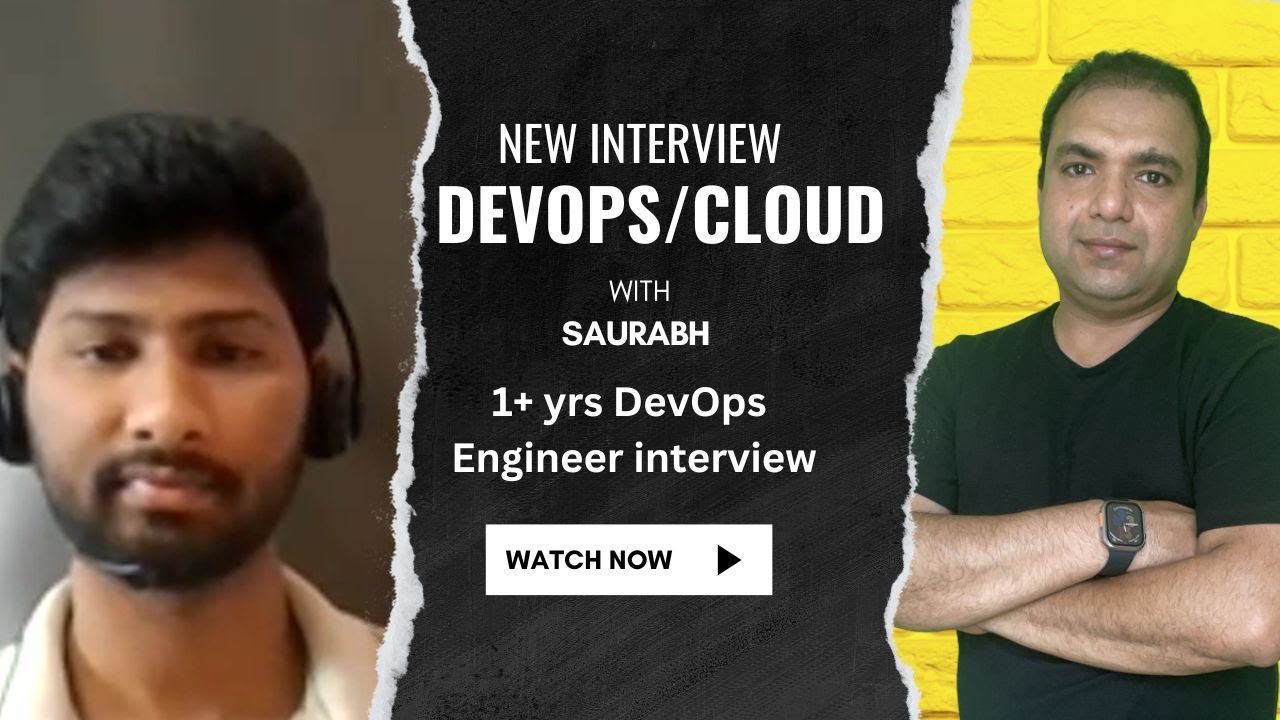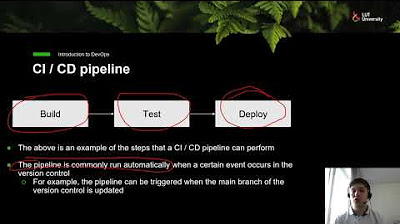How I Failed ₹20 LPA devops interview | Live recording
Summary
TLDRIn this interview, the candidate demonstrates a strong foundation in DevOps practices, particularly in automation, cloud infrastructure, and CI/CD pipelines. With experience in AWS, Jenkins, Docker, Kubernetes, and Ansible, they can independently handle automation tasks and manage deployments. While knowledgeable in these areas, the candidate could benefit from further exposure to advanced monitoring, Azure integration, and cross-platform incident handling. Their proactive learning attitude and hands-on approach make them suitable for mid-level DevOps roles, with a need for some mentoring in complex integrations and advanced practices.
Takeaways
- 😀 The candidate has 3 years of IT experience, with 1.5 years focused on DevOps, primarily working with AWS, Kubernetes, Docker, Jenkins, and CI/CD pipelines.
- 😀 He has hands-on knowledge of AWS services including EC2, VPC, Route 53, CloudFront, IAM, Auto Scaling, and Load Balancing, with experience building resilient and secure applications.
- 😀 Demonstrates strong Git knowledge, including understanding the difference between git pull and git fetch, creating branches, and basic commit management.
- 😀 Familiar with CI/CD concepts, continuous integration, continuous deployment, and delivery, and has experience automating build, test, and deployment processes.
- 😀 Skilled in automation using Ansible and Terraform, capable of creating playbooks and scripts to automate server setup, application deployment, and configuration updates.
- 😀 Has basic knowledge of monitoring tools like Prometheus, Grafana, and ELK, and understands how to set up monitoring dashboards for clusters and applications.
- 😀 Understands Agile methodology and DevOps principles, emphasizing faster deployment cycles, automation, and minimizing manual intervention.
- 😀 Shows problem-solving abilities and independence, able to complete individual projects end-to-end without external help, using research and troubleshooting skills.
- 😀 Demonstrates awareness of DevOps KPIs and metrics, such as recovery time from failures (MTTR), but needs more hands-on experience with postmortem analysis and advanced KPI tracking.
- 😀 Shows adaptability and willingness to learn new tools and processes, indicating potential for growth in cloud-native monitoring, advanced Git operations, and integration of DevOps pipelines with cloud services.
- 😀 Capable of explaining technical concepts clearly, providing step-by-step approaches for deployment automation, including handling image updates and pipeline scripting.
Q & A
Can you summarize Muthu's professional experience in DevOps?
-Muthu has 3 years of IT experience, with 1.5 years focused purely on DevOps. He has worked with AWS services, Kubernetes, Docker, Jenkins, Ansible, Terraform, and has basic Python knowledge. He has hands-on experience in automation, CI/CD pipelines, monitoring setups, and cloud infrastructure deployment.
What is the difference between 'git pull' and 'git fetch' according to the interview?
-'git pull' fetches updates from the remote repository and merges them into the current branch, updating the working directory. 'git fetch' only retrieves updates from the remote repository to the local repository without modifying the current working directory.
How does Muthu handle creating new branches in Git?
-Muthu creates new branches using 'git branch <branch_name>'. He uses separate branches for testing and feature development and is familiar with developer, release, and hotfix branch strategies.
What CI/CD tools and processes is Muthu experienced with?
-Muthu has experience with Jenkins for CI/CD pipelines, GitHub for version control, and automating build, test, and deployment processes. He can automate image updates in Kubernetes manifests and integrate pipelines for seamless deployment without manual intervention.
How does Muthu approach DevOps automation and scripting?
-He uses Ansible playbooks to automate server provisioning, application installation, and configuration. He reduced deployment time from 30 minutes manually to 2 minutes using automation. He also scripts WAF setup, server hardening, and multi-server deployment.
What monitoring tools does Muthu use and how?
-Muthu uses Prometheus for cluster monitoring, Grafana for dashboards and metrics visualization, and ELK stack for logging. He can design a monitoring strategy without pre-existing tools by using agents to collect data, storing it centrally, and connecting to dashboards like Grafana.
Can Muthu manage cloud infrastructure in AWS?
-Yes, he has experience with EC2, VPC, Route 53, CloudFront, S3, IAM, Auto Scaling, and Load Balancers. He knows how to set up highly available, secure, and resilient applications and perform backups using AWS tools such as MARS.
What gaps in experience did Muthu have according to the interview?
-Muthu has limited hands-on experience with GitLab-AWS/Azure integration, formal KPI tracking, postmortem analysis, and Grafana metrics collection directly from AWS VMs. He is aware of these areas conceptually but hasn’t fully implemented them.
How does Muthu approach problem-solving when working individually?
-He proactively researches solutions, uses online resources like Stack Overflow and ChatGPT, and tries to solve problems independently. He emphasizes diagnosing errors, automating repetitive tasks, and completing projects without external help.
What is Muthu's understanding of continuous integration, continuous delivery, and continuous deployment?
-Continuous Integration (CI) involves integrating code from multiple developers and running automated builds/tests. Continuous Delivery (CD) ensures the application is always deployable but may require manual deployment. Continuous Deployment automates both building and deployment without manual intervention.
How does Muthu explain DevOps KPIs?
-He mentioned basic KPIs like time to recover from failures and customer satisfaction. While he didn’t fully grasp all parameters, he understands the importance of measuring recovery time, issue frequency, and ensuring continuous service availability.
How does Muthu implement automation in CI/CD pipelines for Kubernetes deployments?
-He automates image updates in manifest files using GitHub APIs and pipelines. Jenkins builds the project, updates the manifests, and Argo CD deploys the changes to Kubernetes, ensuring the process is fully automated without manual intervention.
Outlines

This section is available to paid users only. Please upgrade to access this part.
Upgrade NowMindmap

This section is available to paid users only. Please upgrade to access this part.
Upgrade NowKeywords

This section is available to paid users only. Please upgrade to access this part.
Upgrade NowHighlights

This section is available to paid users only. Please upgrade to access this part.
Upgrade NowTranscripts

This section is available to paid users only. Please upgrade to access this part.
Upgrade NowBrowse More Related Video

Interview of Smart Fresher who got 2 DevOps jobs #devops #freshers #freshersjobs #devopsjobs #cloud

Excellent interview with a DevOps engineer with one year's experience

Day-19 | Jenkins ZERO to HERO | 3 Projects Live |Docker Agent |Interview Questions | #k8s #gitops

Introduction to DevOps - CI / CD

Day-18 | What is CICD ? | Introduction to CICD | How CICD works ? | #devops #abhishekveeramalla

Should You Learn AWS, DevOps & Cloud Computing in 2025?
5.0 / 5 (0 votes)